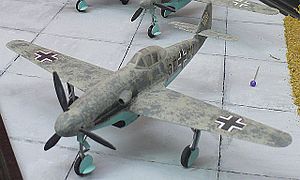| Me 309 | |
|---|---|
| Me 309 | |
| Role | Fighter |
| Manufacturer | Messerschmitt |
| Designer | Willy Messerschmitt |
| First flight | 18 July 1942 |
| Retired | 1943 |
| Status | Experimental |
| Primary user | Luftwaffe |
| Number built | 4 |
| Developed from | Messerschmitt Bf 109 |
The Messerschmitt Me 309 was a prototype German fighter designed in the early years of World War II to replace the Bf 109. Although it had many advanced features, the Me 309's performance left much to be desired and it suffered from so many problems that the project was cancelled with only four prototypes built. The Me 309 was one of two failed Messerschmitt projects intended to replace the aging Bf 109, the other being the Me 209 of 1943.
Design and development[]
The Me 309 project began in mid-1940, just as the Bf 109 was having its first encounters with the Spitfire in the Battle of Britain, the first aircraft to match the 109 in speed and performance. Already, Messerschmitt anticipated the need for an improved design to replace the Bf 109. The Reich Air Ministry, however, did not feel the same urgency, with the project given a low priority resulting in the design not being finalized until the end of 1941.
The new fighter had many novel features, such as tricycle landing gear (with a nose gear strut that twisted through 90° during retraction, to a "flat" orientation under the engine) and a pressurized cockpit, which would have given it more comfortable and effective high-altitude performance. Each of the new features was first tested on a number of Bf 109F airframes, the V23 having a ventral radiator, the V31 with radiator and tricycle landing gear, and the V30 having a pressurized cockpit.
Low government interest in the project delayed completion of the first prototype until spring 1942, and trouble with the nose wheel pushed back the 309's first flight to July. When it did fly, the Me 309's performance was satisfactory – about 50 km/h (30 mph) faster than a standard Bf 109G – but not exemplary. In fact, the Bf 109G could out-turn its intended replacement. With the addition of armament, the aircraft's speed decreased to an unacceptable level. In light of its poor performance and the much more promising development of the Focke-Wulf Fw 190D, the Me 309 was canceled.
In 1943, Messerchmitt made one last attempt at creating a replacement for the Bf 109 in the form of the Me 209-II. It was essentially a modification of the existing 109 airframe, Messerschmitt designers not wanting to invest the time and trouble in a new design like the Me 309.
Specifications (Me 309)[]

Top view of the Me 309
Data from Die Deutsche Luftrüstung 1933-1945[1]
General characteristics
- Crew: 1
- Length: 9.46 m (31 ft 0 in)
- Wingspan: 11.04 m (36 ft 3 in)
- Height: 3.9 m (12 ft 10 in)
- Wing area: 16.6 m2 (179 sq ft)
- Empty weight: 3,530 kg (7,782 lb)
- Gross weight: 4,250 kg (9,370 lb)
- Powerplant: 1 × Daimler-Benz DB 603G inverted V-12 liquid-cooled piston engine, 1,287 kW (1,726 hp)
Performance
- Maximum speed: 733 km/h (455 mph; 396 kn)
- Cruising speed: 665 km/h (413 mph; 359 kn)
- Range: 1,100 km (684 mi; 594 nmi)
- Service ceiling: 12,000 m (39,370 ft)
- Wing loading: 256 kg/m2 (52 lb/sq ft)
- Power/mass: 0.31 kW/kg (0.19 hp/lb)
- Armament
- Guns:
- 2 × 15 mm (.59 in) MG 151 cannon
- 3 × 13 mm (.51 in) MG 131 machine guns
See also[]
- Bf 109
- Me 209
- Me 209-II
- Me 409
- Me 509
- Me 609
- List of aircraft of World War II
- List of military aircraft of Germany
- List of World War II military aircraft of Germany
References[]
- Notes
- ↑ Nowarra 1993, pp. 215–218.
- Bibliography
- Green, William. War Planes of the Second World War, Fighters, vol. I. London: Hanover House, 1960.
- Jackson, Robert. Infamous Aircraft: Dangerous Designs and their Vices. Barnsley, Yorkshire, UK: Pen and Sword Aviation, 2005. ISBN 1-84415-172-7.
- Nowarra, Heinz J. Die Deutsche Luftrüstung 1933-1945: Band 3 Flugzeugtypen Henschel–Messerschmitt. (in German). Bonn: Germany: Bernard & Graefe Verlag, 1993, pp. 215–218. ISBN 3-7637-5467-9.
External links[]
| Wikimedia Commons has media related to Messerschmitt Me 309. |
The original article can be found at Messerschmitt Me 309 and the edit history here.
